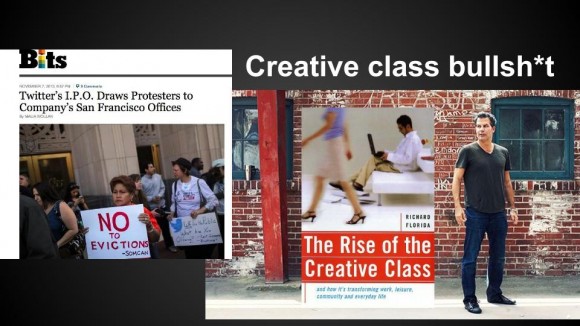Here is a copy of the talk that I gave at the “First International Conference on the Links between USA and Spain” in April, 2014 at the University of Alcala. The title of the talk is “From Sharing to Cooperation: Lessons from Mondragón in the ‘New Economy.'”
As you may know, the phrase “the new economy” emerged in the late 1980s and 1990s and it is by no means “new” at this point, but rather points us toward an economy that has decidedly moved from Fordist arrangements of labor and production to what has been referred to as “post-Fordist”, relying on “flexible” or causalized labor and “just in time” production. Within that larger framework of a “new” economy, we have witnessed the rise of what is more specifically called “the sharing economy” and, in this paper, I sketch the terrain of labor, technology, data, and value that this phrase has come to indicate. I do this, however, because I am interested in interrogating the social figure– the private, entrepreneurial individual –that sits at the heart of this emerging economy. I do this because I want to argue that the “sharing economy”, while seemingly rapidly multiplying and spreading across several realms of social life, is an unsustainable and exploitative labor arrangement that privileges the short-term interests of individuals, while simultaneously opening the individual and environments and objects (such as homes) to data extraction and surveillance.
As we will see as I outline this terrain, many seem resigned to this fate of “dataveillance”, while others speak of it as a new, transformative mode (often through the language of disruption and innovation) of social and economic relations that will fundamentally alter how we live. That transformative vision carries with it several social problematics, which I will address. It is, then, within this larger critique that I am making of the sharing economy that I turn to Mondragón to ask about sustainable forms of “sharing.” I turn to Mondragón here to ask the question: How might we move from an extractive “sharing” economy to a form of economy that is truly capable of sustaining communities?
My work here is inspired by a movement, which is taking place in New York called “platform cooperativism.” As Trebor Scholz has written, this movement would bring about “worker–owned cooperatives” that “could design their own apps-based platforms, fostering truly peer-to-peer ways of providing services and things, and speak alternatives to the new platform capitalists.” I will return to Scholz’s notion of platform cooperatives at the end of my talk, but I will also take Mondragón specifically into consideration because I think it offers us a larger vision of what is possible and perhaps helps us to see the social and economic stakes of our current data economy. In this paper I argue we need not only new platforms, but a more fully re-conceptualized sense of what work and labor might be and the social relations such labor might engender.
Let me back up for a minute and sketch out the phrase “sharing economy” so that we have a sense of both what it purports to be and what it relies upon. On the surface, the sharing economy has emerged as a series of platforms that enable individuals to use the Web to provide a variety of services and commodities on a peer-to-peer level. The large players in this economy are currently Airbnb, Uber, TaskRabbit, but there has really been a proliferation of these platforms. Currently, you can find platforms that will allow you to hire an individual to clean your house, conduct domestic repairs, bring you lunch, walk or “borrow” your dog, eat with someone, cook you a meal, find you a parking space, or carpool, baby sit your children and, generally, the business model here is that if something requires “care”, that care can be outsourced, as well as monetized via an informal labor arrangement in which individuals simply accesses a platform to set the terms of demand and supply. This “sharing” economy is often touted as being mutually beneficial to both parties. The person who needs their house cleaned bypasses any middle man and simply hires an individual cleaner for a few hours and the individual cleaner, it is assumed, voluntarily and knowingly enters into this arrangement because this allows them to work “flexibly” and “on their own terms.” Here, managers and bosses are replaced with what seems to be no one, except of course those developing and designing the platform code and analyzing its quite valuable data. The data element here, of course, is designed to remain faceless, as though sharing economy platforms simply emerge out of the good will of well-meaning entrepreneurs who see an opportunity to “connect” people or resources.
This hidden world of code and algorithmic labor is what Frank Pasquale refers to a “black box society” or a society in which the very algorithms that come to shape and inform our lives are obscured from us. This phrase should be immediately resonate with anyone who has recently used the Internet, particularly a service like Amazon. Amazon exists as set of conveniences, acquiring data from our every click, yet we have no access to the code the set those preferences, nor do we have access to the ways in which our data is analyzed, shared, or sold. Perhaps even more troubling, we might not even see this as a problem or believe that we have a right to that information or computational process.
While the sharing economy has often been touted as a new mode of living in which people empower themselves through participating in this new, digitally mediated (seemingly ephemeral) project of crowdsourcing, I would argue that the sharing economy is actually predicated on creating new terrains of rent and that participation here—the very peer-to-peer collaboration and that supposedly leads to greater choice and flexibility—is dependent, first and foremost, on having something to “share” or what we might think of as “something that can be offered up to the digital platform, or something that can be made data-ful.” That something can be a home, a car, pets, time, talents, attention and individuals are often invited to share through the most practical of all invitations—the creation of passive income, or rent. Guy Standing writes, “Rental income enables people to make money simply through the possession of scarce assets. Sometimes assets may be ‘naturally’ scarce: if fertile land is owned by a few landlords, they need not work themselves but can rent it out to others for a high price. This income is rent, not profits from a productive activity, as the landlords do nothing to earn it aside from owning the land.”
And, whether you are renting your home out or you are picking up odd jobs through Uber or TaskRabbit, the social figure of this economy is that of the enterprising, entrepreneurial individual. The rhetoric of the sharing economy has actually been quite good as democratizing this figure— We can all be entrepreneurs of our selves or what Foucault referred to as “homo economicus.” Here, production and consumption tend to collapse into one another as though this could “do away with” the messy world of work labor. However, this social figure, I would argue, should actually be thought of as the PR wing of a very powerful anti-labor lobby, which has much more to do with restructuring the nature of various legislations and regulations (and yet, in a sort of classic neoliberal move, extend the nature of governance.) As you may know, platforms such as Uber and Airbnb have been very vocal in “disrupting” local regulatory systems. In December of 2014, a Spanish judge, following a complaint by the Madrid Taxi Association, ruled that Uber drivers didn’t have official authorization and accused the service of “unfair competition.” On the same day, judges in The Netherlands banned UberPop ride-sharing service, which was launched as a pilot project in Amsterdam, with the Hague-based Trade and Industry Appeals Tribunal reporting, “Drivers who transport people for payment without a license are breaking the law.” These companies, however, often argue that they should be exempt from existing regulations because their services are ordered over the Web and therefore not subject to “local” regulation.
Indeed, we can see the “sharing economy” and its rhetoric of individualism as one wing of a much larger fight against labor, labor law, and labor’s rights to organize. In many ways, the sharing economy is simply a continuation of a much longer, historical assault against organized labor globally and we would be remiss if we did not recognize the global aspirations here. The sharing economy is a social form that is emerging in tandem with what anthropologist Julian Brash refers to as a new form of a capitalist class—that of the transnational capitalist (or the TCC.) This is not simply a professional managerial class that we saw rise in the 1980s and 1990s, but is a global, mobile strata that takes the world, particularly as we see in the work of David Harvey and Saskia Sassen, urban cities, as spaces of necessary investment and capture. And, of course, the flip side of this global aspirational class is the extension of massive income inequality and dispossession lived out through a wide range of social processes including gentrification, but also the casualization of work and the making of microforms of work, work that purposefully will no longer be recognized, formally, as work.
This is the really the goal of Uber, which refuses to see itself as an employer. Rather, it claims it is simply a “tech company.” Those who take up the platform to either seek the services or to rent out their services (and property such as their own car) are required also to take on the risk of the company. In this way, the sharing economy is as much about the degradation of labor as it is about “connecting” individuals to one another.
Indeed, there is much we could talk about here in terms of the future of work, but for the remainder of my time I would like to take up the claim that Dean Baker recently made, which is that “rather than try to squash sharing-economy companies, which would almost certainly not be possible, in any case, a far better strategy for progressives is to take advantage of the innovations they offer and restructure them in ways that ensure that the public and service providers all benefit. This can be done, if we are prepared to try some new tactics.”
Here, is where I would like to shift gears and argue that these lessons can indeed come from Mondragón. While there is again much we can talk about here, I would like to focus on four specific lessons that Mondragón—the world’s largest worker cooperative— offers the discussion of the sharing economy. Those lessons are what am I labeling 1.) A pragmatic ideal 2.) Social investment 3.) Equilibrio or the blending of entrepreneurship and community care 4.) and the role that education together with technology must play in charting a course out of the exploitation of the data economy. Let me simply turn to each of these lessons.
Pragmatic ideal: The first lesson that Mondragón offers is a quite an idealistic one, but something that must be reiterated: The future of labor is not written. As Trebor Scholz has written, “there is no one future of labor” and despite the rambunctious rhetoric of the digital economy and its algorithmic wisdom, which at turns threatens to both put us all out of work, as well as automate fully the very nature of work, it is essential that we realize another way forward is possible—a way that places humans back at the heart of the economy. More and more this simple injunction to the social imaginary feels like a radical act, as though we forget that humans code and create algorithms. They are not gods nor are they pre-determined and that there is no reason (aside from very powerful political interests) that these incredible technologies cannot be put toward new and better ends. In this regard, the history of Mondragón, with its birth in both the exclusion of Fascism and the insights of what seems to be a rather charismatic figure of Jose Maria Arizmendiarrieta, is actually a testament to the ability of humans to find a path forward for communities within dire conditions.
Social Investment: While mentions of Mondragón often bring objections that the very specific political, economic, cultural and religious conditions of Mondragón’s establishment make it an unreplicable model, these arguments were already discredited in 1975 by the sociologist William Foote Whyte who argued that while we must be close students of history there is much to be learned from the organizational lessons of Mondragón, specifically the ways in which banking, education, and technology were understood as fundamental to the success of the endeavor. In the words of Arizmendiarrieta, “cooperativism without the structural capacity to attract capital and assimilate capital at the level of the requirements of industrial productivity is but a temporary solution” and it is here that I want to argue that Mondragón, in its slow, deliberate process of making what I call a “social choice” to build the underlying institutions which would then support a cooperative social organization offer us one of its strongest lessons. As Roy Morrison has suggested in his social history of Mondragón, the project was nothing less than a deliberate attempt to produce a new social reality through investment and through a restructuring of the financial and technological supports that give rise to an ecology of cooperatives. In a time when venture capital rules the terms of development, such a restructuring of the flows of capital is essential. As I will argue in the conclusion of the paper, that social choice needs to be fully contemplated, specifically when we begin to think about the future of those who code and the role that education can play.
Equilibrio: From Entrepreneurialism to Community: The third lesson that Mondragón offers is the realization that the language of entrepreneurialism need not be solely the purview of the individual, but rather can be modulated to reflect a larger concern with community, the environment, and the future. As Foucault has so articulately shown us, neoliberalism’s insistence that the entrepreneurial self come to stand in for an ethical mode of living has been embraced as a fait accompli, as a sort of bottom line subjectivity for bottom line thinking. Mondragón stands as a testament that participation in the market can be put toward a greater good and that the process of seeking equilibrio can be a collective ethical practice, capable of producing substantive resources for more than a single person.
The role of education: Finally, and perhaps to me the most interesting lesson that Mondragón offers is the role that education, the university, and technology must play in the development of cooperative institutions. The example of Mondragón forces us to consider two interwoven — and deeply political — societal goals of education. These goals are to create an informed citizenry and to develop the skills for a workforce, which as we know is a workforce being put out of work. We have, at least in the United States, been very eager to adopt technology as means of “solving educational” problems, yet we do this with technology and code and data that students (and faculty) rarely see or touch. Mondragón offers the example that students must become producers of both the technologies and the modes of investment that guide the development of these technologies. If there is any hope to build a sustainable future of equitable resource distribution is lies in unveiling the contemporary economic moment to students AND equipping them with the technological skills to rebuild. It also will require providing models such as Mondragón, which can provide a new blueprint for economic organization and social and cultural existence.







